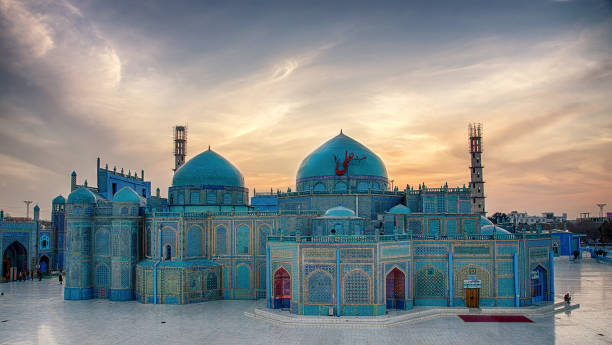Explore the Heart of Northern Afghanistan, Known for Its Sacred Sites, Vibrant Markets, and Cultural Richness.

Mazar-i-Sharif, often referred to as the cultural and spiritual heart of northern Afghanistan, is famous for its stunning Blue Mosque and rich historical significance. This vibrant city, steeped in centuries of tradition, is a major pilgrimage site and offers visitors a glimpse into Afghanistan’s cultural diversity and heritage. Whether you're visiting the Blue Mosque, exploring local markets, or taking in the sights of nearby Balkh, Mazar-i-Sharif offers a unique and unforgettable experience. Here's your guide to all the best things to see, do, and know before you visit.
Mazar-i-Sharif, translating to "Noble Shrine," owes its name and prominence to the Shrine of Hazrat Ali, the cousin and son-in-law of the Prophet Muhammad. Legend has it that the body of Hazrat Ali is buried here, making the city one of the holiest Islamic sites in Afghanistan. The city grew around this shrine, becoming not just a spiritual center but also an important hub for trade and culture.
In ancient times, Mazar-i-Sharif served as a key city along trade routes connecting Central Asia to the Indian subcontinent. Its historical significance is also linked to nearby Balkh, known as the "Mother of Cities," which played a central role in the region's early civilizations.
Mazar-i-Sharif is deeply rooted in religious and cultural traditions. The city is home to diverse ethnic groups, including Tajiks, Uzbeks, Hazaras, and Pashtuns, all of whom contribute to its vibrant cultural landscape.
The city's identity is strongly tied to its spiritual significance, with the Blue Mosque (also known as the Shrine of Hazrat Ali) being a major pilgrimage destination, especially during the annual Nawroz (Persian New Year) celebrations. This festival marks the start of spring and attracts thousands of people, who come to witness the traditional raising of the Janda (flag) at the Blue Mosque, a symbol of hope and renewal.
The best time to visit Mazar-i-Sharif is in the spring (March to May), especially during Nawroz, when the city is alive with celebrations and the weather is mild. Autumn (September to November) is another pleasant time to explore the city, with cooler temperatures perfect for sightseeing.
Afghan cuisine in Mazar-i-Sharif is a delightful blend of Central Asian flavors. Some must-try dishes include:
Don't forget to enjoy green tea with your meal, a staple in Afghan hospitality.
Mazar-i-Sharif is home to several historical and cultural landmarks that you shouldn’t miss:
Visa Requirements: Ensure you have a valid Afghan visa before traveling, and always carry a copy of your passport.
Currency: The local currency is the Afghani (AFN). Cash is essential, as most transactions in the markets are done with physical money.
Language: Dari and Uzbek are the most commonly spoken languages, though English is spoken in some tourist areas.
Mazar-i-Sharif has historically been a relatively peaceful city compared to other parts of Afghanistan, but it's always important to stay informed. Check the latest travel advisories and avoid areas that are less secure. Hiring a local guide can be helpful in navigating the city safely and ensuring you stay in tourist-friendly zones.
There are a range of hotels and guesthouses available in Mazar-i-Sharif, from budget options to more comfortable stays:
Getting to Mazar-i-Sharif: The easiest way to reach Mazar-i-Sharif is by flying from Kabul to Mazar-i-Sharif International Airport. The flight takes about an hour. Alternatively, you can travel by road, but it’s advisable to check security conditions beforehand.
Getting Around: Taxis are the most common way to get around the city, but many key sights are walkable from the city center.
In case of emergencies, have the following contacts at hand:
Mazar-i-Sharif’s bazaars are full of treasures, from handwoven Afghan rugs to saffron and traditional jewelry. You’ll also find beautifully crafted ceramics and pottery that make great souvenirs. If you’re in the city during Nawroz, you’ll experience vibrant public celebrations, traditional music, and dancing in the streets near the Blue Mosque.
Mazar-i-Sharif has a semi-arid climate, with hot summers and cool winters. Spring and autumn are the most comfortable seasons for exploring, with mild temperatures and clear skies. Summers can be extremely hot, with temperatures reaching over 40°C (104°F), so be prepared with sun protection if you visit during that time.
The most commonly spoken languages in Mazar-i-Sharif are Dari and Uzbek, though many residents also speak Pashto. English is less common but can be found in hotels and with some local guides.
3-Day Itinerary: Explore the Spiritual and Historical Heart of Northern Afghanistan
Day 1: Spiritual Mazar
Day 2: History and Heritage
Day 3: Cultural Insights
If you have more time, consider visiting Kunduz or Kabul. Kunduz offers a quieter, rural experience, while Kabul, the bustling capital, provides a mix of modern and historical attractions.
Mazar-i-Sharif is a city that beautifully combines spiritual significance with historical depth and cultural vibrancy. From the iconic Blue Mosque to the lively bazaars and nearby ancient city of Balkh, Mazar offers an enriching experience for any traveler. Whether you’re drawn by the religious importance of the Shrine of Hazrat Ali or the rich history that permeates every corner of the